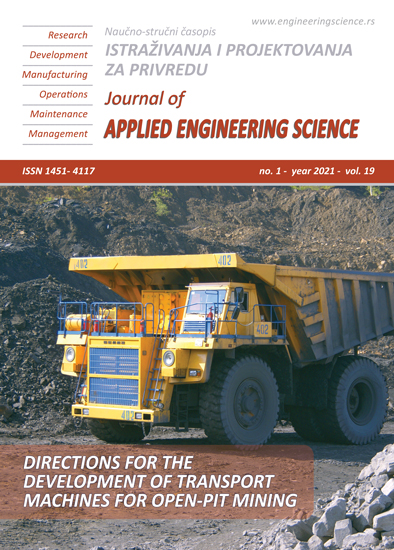CHIP FORMATION DURING THERMAL FRICTION TURN-MILLING
Abstract
This paper presents the results of chip formation studies in the processing of 30KhGSA steel by thermofriction turn-milling. When studying the process in this work there are presented the results of studying chip formation when the processing of chip formation there is used the metallographic method. Chip root area investigated. The dependence of the chip shrinkage coefficient on the cutting speed and feed was also investigated. It is established that with increasing supply S the value of the chip shrinkage coefficient K decreases. The higher the chip shrinkage factor, the more work will be required to cut the chips and the more complex the processing process.
References
Kravchenko, N.S., Pegashkin, V.F. (2015). Analysis of milling schemes. Materials of the International Scientific and Practical Conference. 2 v. Т1. FGAOU VPO «Ural Federal University named after the first President of Russia B.N. Yeltsin», Nizhnetagil Tech. Inst. - Nizhny Tagil: NTI (branch) UFU, Р.51-56.
Selivanov, A.N., Nasad, T.G., Tormanov, S.Y. (2011). Experimental investigations of chip formation during processing of titanium alloy VT 1-0 with the method of high-speed circumferential milling. Bulletin of the CSTU. №2(56). Issue 2.- Р.138-144.
Sherov, K.T., Mussaev, M.M., Kokkoz, M.M. (2018). The method of thermofriction milling and milling friction. Patent RK No. 32933 for the invention. Published on July 5th. Bull. Number 25.
Khodzhibergenov, D.T., Esirkepov, A., Sherov, K.T. (2015). Rational milling of metals. Russian Engineering Research. Allerton Press, Inc. Vol. 35. No 1. pp. 43-45. DOI: https://doi.org/10.3103/s1068798 x1501013x
Sherov, K.T., Sikhimbayev, M.R., Sherov, A.K., Donenbayev, B.S., Rakishev, A.K., Mazdubay, A.V., Musaev, M.M., Abeuova, A.M. (2017). Matematical modeling of thermofrictional milling process using ANSYS WB software. Journal of Theoretical and Applied Mechanics, Sofia, Vol. 47, No. 2, P. 24-33. https://doi.org/10.1515/jtam-2017-0008
Sherov, K.T., Sikhimbayev, M.R., Nasad, T.G., Absadykov, B.N., Izotova, A.S., Okimbayeva, A.E., Кuanov I.S. (2020). The research of the steel cutting blade reliability for thermo-frictional processing. News of the National Academy of Sciences of the Republic of Kazakhstan. Series of geology and technical sciences. Volume 1, Number 439, P.122 – 130. https://doi.org/10.32014/2020.2518-170X.15
Sherov K.T., Mussayev, M.M. (2016). Calculation of shrinkage ratio for processing 30KhGSA steel with milling. Mechanics and technology. – Taraz: Publishing house "Taraz University" TarSU them. M.H. Dulati, №3- Р.36-42.
Loladze, T.N. (1982). Chip formation at cutting of metals. - Moscow: Mashgiz, 204 p.
Bannov, K.V., Valkevich, K.V., Matveev, V.S. (2006). Analysis of the phenomena of crushing and curling chips. Bulletin of the Kurgan state University. Series "Technical Sciences". - Vol. 2. - Kurgan: Publishing house of Kurgan state University, Part 1. - P. 14-15.
Nasad, T.G., Sherov, K.T., Absadykov, B.N., Tusupova, S.O., Sagitov, A.A., Abdugaliyeva, G.B., Okimbayeva, A.E. (2019). Formation management in parts processing regenerated by surfacing. News of the National Academy of Sciences of the Republic of Kazakhstan. Series of geology and technical sciences. Vol. 3, N 435. P. 102-108. DOI: https://doi.org/10.32014/2019.2518-170x.74
Komanduri, R., Brown, R.H. (1981). On the Mechanics of Chip Segmentation in Machining. Transactions of the ASME. – J. Eng. Ind. Feb., 103(1) - P.3-51. DOI: https://doi.org/10.1115/1.3184458
Zelinsky, A.N., Nazarov, A.K. (1967). Influence of geometrical parameters of the tool on character of a shaving. Diamond-abrasive processing: materials of the 4th Conference of toolmakers of the Western Urals. - Perm, P. 128-131.
Luttervelt, C.A., Pekelharing, A.J. (1977). The split shearzone-mechanism of chip segmentation. CIRP Ann. - № 1., 26р.
Sherov, K.Т., Sikhimbayev, M.R., Absadykov, B.N., Sikhimbayeva, D.R., Buzauova, T.M., Karsakova, N.G., Gabdysalyk, R. (2018). Сontrol’s accuracy improvement and reduction of labor content in adapting of ways of metalcutting tools // News of the National Academy of Sciences of the Republic of Kazakhstan. Series of geology and technical sciences. Vol. 6, N 432. P. 170-179. DOI: https://doi.org/10.32014/2018.2518-170x.47
Garshin, A.P., Fedotova, S.M., Edited, B.Y. (2018). Material science in 3 volumes. Volume 1. Abrasive materials: textbook for academic bachelor. - 2nd ed., corrected and additional - Moscow: Yurayt Publishing house, 214 p.
Klushin, M.I. (1978). Cutting of metals. Elements of the theory of plastic deformation of the cut layer. Vol. 2, Revised Mashgiz – 456р.
Yascheritsyn, P.I., Eremenko, M.L., Feldstein, E.E. (1990). Theory of cutting. Physical and thermal processes in technological systems: Studies. for universities. – Int.: High school., 512 p.
Ryzhkin, A.A. Chuchev, K.G., Klimov, M.M. (2008). Material processing by cutting: study manual - Rostov on D: Phoenix – 411p.
Opitz, H., Hucks, H. (1973). The machining process as a problem of Mohr's sliding surface theory for the two- and three-axis stress state, «Werkstattstechnik und Maschinenbau», N 6, pp. 253-260.
Kushnazarov, I.K., Sherov, K.T., Altynbaev R.R. (2007). Technology termo-frictional milling with high frequency cooling. High technology in engineering: Collection of scientific articles NTU "KhPI".- Kharkov -Vol.2(15).- P. 134-139.
Selivanov A.N. (2011). Increase of productivity and quality of processing of bodies of rotation from titanium alloys by the method of high-speed milling and milling: dis. Cand. tech. sciences. Saratov state tech. University, Saratov.
Loladze T.N. (1982). Strength and wear resistance of the cutting tool M.: Engineering - 320p.

